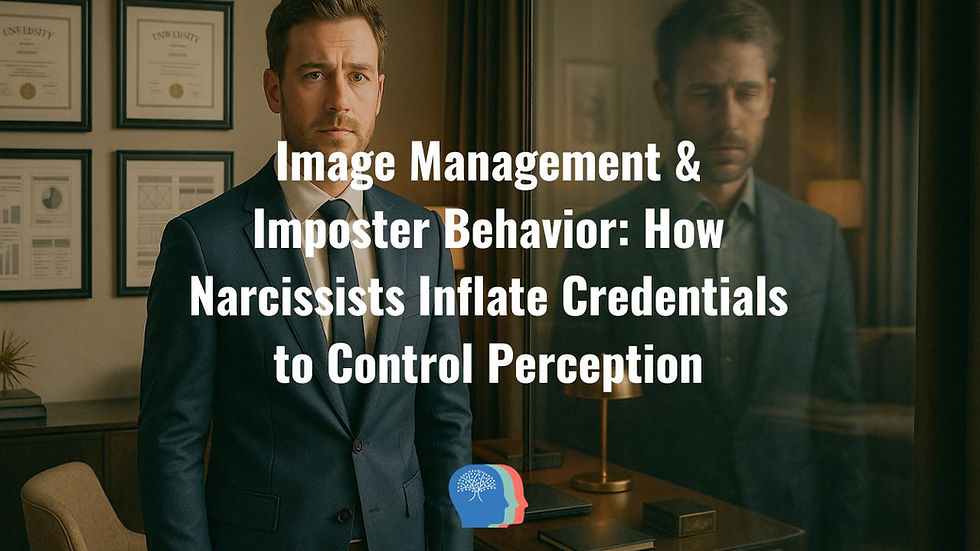Image Management & Imposter Behavior: How Narcissists Inflate Credentials to Control Perception
- Editorial Staff

- Oct 21
- 4 min read
Understanding the False Expertise, Arrogance, and Manipulation Behind Narcissistic Status Inflation

Have you ever encountered someone who constantly shifts their professional identity, claims an array of impressive-sounding credentials, or dominates conversations with supposed expertise that can’t be verified? This isn’t just self-promotion — it’s often a calculated form of narcissistic image management or imposter behavior.
What Is Narcissistic Image Management?
Many individuals with narcissistic traits engage in what psychologists refer to as status inflation or false competence signaling — exaggerating or fabricating skills, education, or experiences to maintain a grandiose self-image. This behavior isn’t rooted in a desire to contribute or collaborate — it's about control, superiority, and admiration.
Why Narcissists Fabricate or Inflate Credentials
1. Grandiosity and Self-Image Maintenance
At the core of narcissistic personality traits lies an inflated self-perception. When reality doesn't match the fantasy of being exceptional, narcissists may rewrite their history to fit their desired identity.
Example: Someone who took a single class in photography may say they “majored in it” or claim to have worked professionally in the field.
2. Imposter Behavior and Strategic Identity Shaping
Rather than building real expertise, narcissists may construct personas that are impressive and ever-changing, tailored to gain admiration or dominance in any social or professional setting. Today, they’re an interior designer: tomorrow, a graphic artist or a branding consultant — depending on the audience.
3. Arrogance as a Defense Mechanism
The chronic need to correct others — grammar, facts, opinions — is often not about accuracy but about maintaining superiority. Narcissists use this condescension to mask deep insecurities and create power imbalances.
4. “Imposter Syndrome” vs. “Imposter Behavior”
It’s crucial to differentiate:
Imposter Syndrome: Competent people doubt themselves internally.
Imposter Behavior: Individuals project false competence to appear more qualified than they are.
Narcissists generally don’t doubt their ability — they expect others to accept the fantasy version of their identity as truth.
5. Social Dynamics and Control
This false expertise manifests in observable social behaviors:
One-upping others’ stories or accomplishments
Rewriting their own past depending on who’s listening
Criticizing others to deflect attention from their own lack of credentials
Elevating themselves as the authority — even in areas where they have no proven background
10 Behavioral Red Flags of Narcissistic Imposters
These red flags often appear in clusters. If you notice multiple traits consistently, it may point to narcissistic imposter behavior:
1. Vague or Shifting Narratives
Their educational or career story changes depending on the conversation or audience.
They avoid details and use phrases like “I studied design” instead of stating degrees or dates.
2. Evasive When Asked for Clarification
When questioned, they become defensive: “That was years ago,” or “I don’t need to prove myself.” This deflection protects them from scrutiny or exposure.
3. Title Inflation
They exaggerate or invent job titles (e.g., “creative director,” “consultant”) without any documented work history or deliverables. Titles are used as shields against being challenged.
4. Correcting Others to Assert Dominance
Grammar policing and know-it-all behavior aren’t about helpfulness — they’re displays of intellectual superiority.
5. Criticism as a Deflection Tool
If confronted, they redirect with cutting remarks or shift blame to others.
“I actually know what I’m doing — unlike some people.”
6. Lack of Verifiable Evidence
No portfolios, no degrees, no proof — just anecdotes and stories.
Genuine professionals typically have a paper trail of accomplishments.
7. Borrowed or Appropriated Identities
They adopt labels from trending or glamorous professions after minimal or no involvement.
“I’m a photographer” (after buying a camera)
“I’m a designer” (after rearranging their own living room)
8. Rage or Smear Campaigns When Challenged
When their story is questioned, they may lash out, accuse others of jealousy, or retaliate with gossip. Exposure often leads to narcissistic injury and a corresponding outburst or attack.
9. Weaponizing Credentials to Control Groups
They hijack discussions by declaring themselves the authority, silencing differing views.
They use unverified expertise to dominate conversations and social power structures.
10. Contempt for Others’ Knowledge
They undermine others’ real experience: “You wouldn’t understand.” Or: “That’s not how it really works.” This protects their fragile self-image when legitimate expertise threatens their authority.
Putting It All Together
While anyone can exaggerate at times out of insecurity, narcissistic imposter behavior goes deeper:
Shifting narratives
Condescending tone
Correcting others for control
No real credentials
Hostility when exposed. Together, these form a recognizable pattern of false expertise, rooted in narcissistic grandiosity and manipulation.
How to Protect Yourself
If you suspect someone may be a narcissistic imposter:
Ask factual questions without emotional charge
Avoid debating — they thrive on control, not truth
Set boundaries when conversations feel manipulative
Document inconsistencies if they affect professional environments
Understanding these patterns allows you to see through the illusion, maintain your self-confidence, and protect your peace.

The information provided in this article is for informational purposes only and is not a substitute for professional advice. We are not licensed clinicians, mental health professionals, lawyers, or legal advisors. For any concerns regarding mental health or personal situations, please seek advice from a qualified professional. For more details, please read our full disclaimer.








Comments